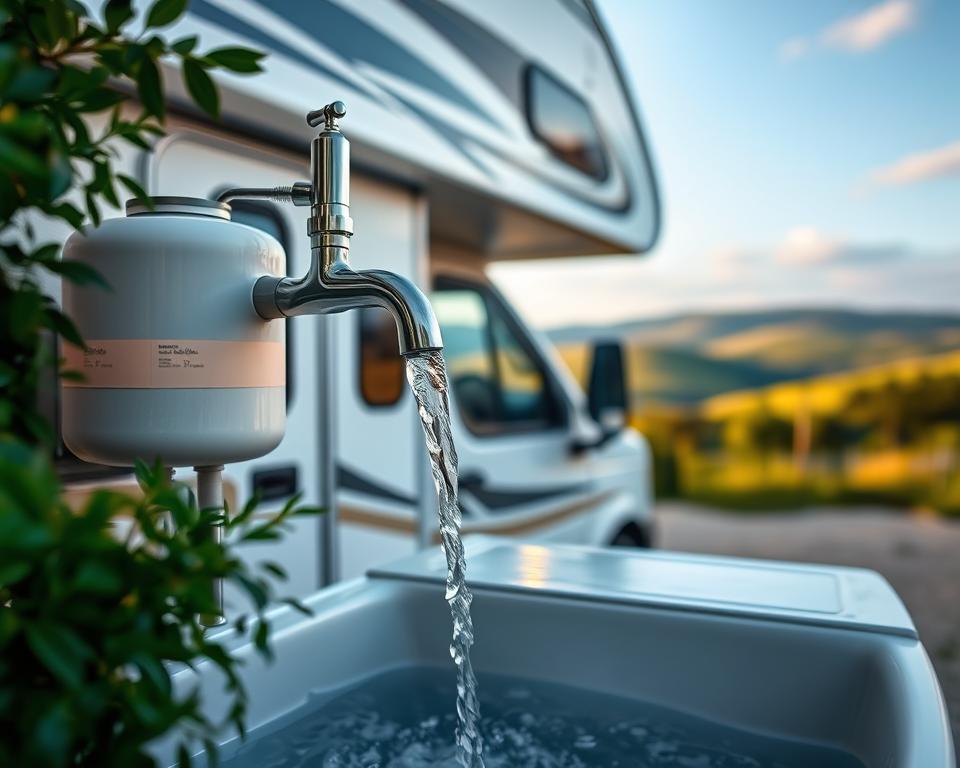RV Sewage Tank Pumping: Key Upkeep Guidelines
Think about the fallout from overlooking your RV’s septic system. Many RV owners find the idea of septic tank pumping daunting. Yet, understanding these upkeep steps is essential. These steps preserve your camping joy and avoid expensive repairs. Learning proper waste disposal is key to your septic health. Here are key pointers on RV waste pump with upkeep advice to ensure your system operates flawlessly.
The Basics of Your RV Sewage System
Every recreational vehicle features a septic setup. It consists of a black tank for toilet use, a gray tank for sinks/showers, plus a freshwater reservoir. Grasping how each part works is key to proper black tank servicing and overall system care.
A series of drain lines and vent pipes balance waste flow and airflow. Understanding this synergy helps you avoid blockages and buildup. It’s the foundation of a smooth camping experience.
Maintaining clear, working tanks requires routine effort. Frequently checking tank levels and emptying on time preserves comfort. By maintaining your RV’s septic system properly, you’ll improve its lifespan and enjoy every trip more.
Why Routine Tank Pumping Matters
Frequent tank pumping keeps your system working and clean. Leftover solids lead to smells and clogs, spoiling your trip. A full tank can produce embarrassing backups. Such mishaps kill the fun on the road.
Skipping pump-outs leads to pricey repairs. System failures cause leaks and wear out parts prematurely. Timely emptying keeps your plumbing running smoothly. You’ll avoid nasty surprises and costly breakdowns.
Proactive servicing stops clogs. Investing in pump-outs shows you care about your RV. It greatly improves your travel experience. By sticking to a dump schedule, you’ll relish the outdoors worry-free.
Finding the Right Dump Frequency
Timing your tank dumps depends on several variables. Common guidance suggests a 3–5-day window. However, it shifts based on tank volume and number of users. Knowing when to pump is vital for managing RV wastewater.
Dump the black tank at about two-thirds capacity. It ensures good drainage and cuts down on odors. Ignoring it can cause backups and unpleasant odors.
Many elements can affect how often you pump:
- Number of people on board
- Length of stay
- Type of waste generated
- Tank capacity
Scheduling prevents on-the-road crises. Sync with any public dump station hours. Knowing your patterns predicts when to dump.
| Usage Scenario | Pumping Frequency |
|---|---|
| Short Trip, Two Campers | Every 3–4 days |
| Extended Trip (4–6 people) | Every 2–3 days |
| Seasonal Living (2–4 people) | Weekly or Bi-Weekly |
Keep a close eye on tank levels and your habits. Staying attentive guarantees a pleasant trip.

Proper Tank Dumping Techniques
Correct dumping preserves system health and prevents issues. Begin with the black tank to avoid cross-contamination. This prevents dirty water from fouling the clean.
Using a high-quality hose minimizes leaks and ensures smooth dumping. Tighten connections to stop spills. After emptying, flush the black tank with plenty of water. It clears lingering waste for a cleaner tank.
Scout dump spots along your route. This preparation streamlines your dump routine.
In short, follow these key steps for efficient dumping:
- Empty the black water tank first.
- Use a top-quality sewer hose.
- Flush the black tank thoroughly after emptying.
- Plan your dump station locations.
Following these guidelines simplifies black tank maintenance.
Tank Handling and Upkeep Best Practices
Knowing proper tank use and maintenance is crucial. Keep some water in the black tank for better breakdown.
Refrain from disposing non-biodegradable items. Always use RV-safe toilet paper to prevent clogs. Inspect tanks often to catch problems early.
Adding treatments now and then improves septic service. They introduce microbes that digest solids effectively. Simple steps ensure smooth tank operation.
- Check for leaks and damage often.
- Apply RV-specific chemical treatments.
- Keep vents clear to avoid odors.
Following these rules protects your septic setup. It also boosts your camping enjoyment.
RV Septic Tank Pumping: Key Tips for Success
Successful pumping requires precision and a clear procedure. It’s essential to use designated dump stations. Know your tank’s capacity to avoid overflows.
Check tank indicators regularly to time pump-outs. This extends tank life and enhances trip comfort. Setting a dumping schedule improves system efficiency.
Flush well after every emptying. It ensures each dump is cleaner than the last. Such tactics keep your rig in top shape and improve your travel experiences.
Common Mistakes to Avoid When Maintaining Your RV Septic System
Upkeep prevents trip interruptions. Insufficient flushing causes solids to accumulate. Proper flushing dissolves waste better.
Wrong flushables cause havoc—never flush wipes or towels. Avoid non-dissolvable products like feminine hygiene items. They cause backups and costly service calls.
Leaving the black valve open too early is a mistake. Open valves let water out but hold solids, causing residue. Only open when ready to empty for a complete clean.
Awareness of these errors boosts system longevity. Steering clear of these mistakes ensures durable performance.
When to Call in Professional RV Waste Disposal Services
Recognizing the need for expert help extends tank life. Lingering smells can mean serious tank problems. Slow drains point to potential clogs or buildup.
Visible residue at dump points requires attention. Such situations usually need high-pressure cleaning. Experts use specialized tools to clear stubborn clogs.
Regular expert check-ups safeguard tank health. Acting on findings quickly prevents bigger problems. Hiring qualified technicians saves time and money long term.
Sustainable Waste Management Strategies
Long-term strategies sustain wastewater efficiency. Regular pumping boosts system life and function. Routine rinses clear residue and stave off expensive breakdowns.
Implementing clean cycles safeguards tank health. Inspecting connections stops leaks before they spread. Choosing eco-friendly treatments avoids damage.
Keep these habits in mind:
- Stick to a pump-out timetable.
- Rinse often to remove solids.
- Sanitize twice a year.
- Inspect parts frequently for wear and tear.
Proactive care delivers worry-free travel. Through consistent upkeep, you’ll enjoy travel free from waste worries.
The Bottom Line
Good septic care ensures enjoyable trips. Understanding operation and following guidelines prevents headaches. Routine black tank dumping boosts performance. It enhances every mile.
By regularly checking and properly caring for your septic setup, you’ll ensure worry-free travel. This reliability supports every outing. These routines prime your rig for future rides. Thus, you can concentrate on adventures rather than septic concerns.

